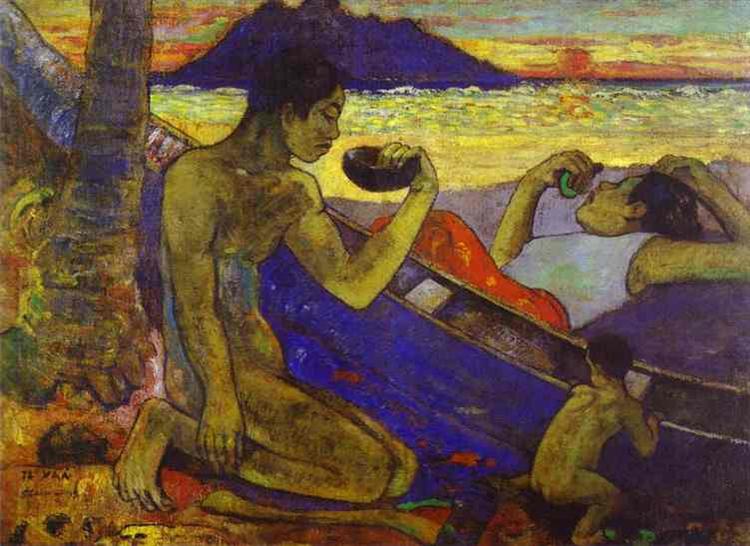תיאור
Paul Gauguin's painting "A Canoe (Tahitian Family)", painted in 1896, is a fascinating testimony to the artist's quest to transcend reality and create a world that combines primitive nature with the spirituality and simplicity of Tahitian life. This painting is part of the aesthetic concerns of Gauguin, a pioneer of post-impressionism who, after his trip to Tahiti, was drawn to the culture and customs of its inhabitants, in a clear rejection of the Western society of his time.
The composition of the work focuses on a group of people gathered in a canoe, with the figure of a woman at the front end of the vessel prominently capturing the viewer’s attention. The artist deploys her signature use of bold color and simplified form, resulting in a harmonious balance evoking both the solidity of the human body and the fluidity of water. Gauguin uses vibrant hues of blues and greens to depict the aquatic environment, while the skins of the individuals are treated with warm brown and ochre tones, suggesting both a connection to the land and a celebration of Tahitian identity.
The scene is rich in symbolism and evokes a sense of intimacy and familiarity. The family members, portrayed with expressions of tranquility and harmony, seem to be immersed in their own world, oblivious to the concerns of the modern world. This aspect of everyday life is intensely present in the painting, suggesting an almost mythical form of existence that Gauguin longed for himself, far from the chaos of Europe. The canoe, as a symbol of travel and adventure, while also anchored in tradition, establishes a dialogue between indigenous culture and the artist’s search for a more authentic life.
The use of color in this work is particularly notable. The palette is intense and expressive, and Gauguin does not simply convey reality, but transforms and elevates it. Every hue and shape becomes an extension of his emotions and philosophical musings. The depiction of light and shadow offers a sense of depth to the scene, while the contours of the figures are defined without the precision of a realistic depiction, which aligns with his purpose of capturing the essence of experience rather than its mere appearance.
Gauguin was a precursor to modern trends in painting, influencing later generations through his innovative use of color and form. Similar works, such as "Dejeuner sur l'herbe" where he advocates breaking with realist conventions, reveal his intention to connect with the viewer on an emotional level, something that can also be seen in "A Canoe (Tahitian Family)". This approach to nature and the spirituality of the Tahitian subjects contrasts sharply with the complexity and industrialization that he anticipated in his life in France.
In conclusion, “A Canoe (Tahitian Family)” is more than a depiction of a fleeting moment in the daily life of a Tahitian household; it is a deep and sensitive exploration of identity, culture, and connection to the environment. Gauguin’s work continues to resonate for its bold aesthetic choices and the way it invites viewers to reflect on their own relationship to the world, through the lens of a life he considered more pure and meaningful.
KUADROS ©, a famous painting on your wall.
Hand-made oil painting reproductions, with the quality of professional artists and the distinctive seal of KUADROS ©.
Painting reproduction service with satisfaction guarantee. If you are not completely satisfied with the replica of your painting, we will refund 100% of your money.

